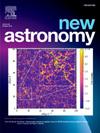Composite pseudo Nambu Goldstone quintessence
IF 2.1
4区 物理与天体物理
Q2 ASTRONOMY & ASTROPHYSICS
引用次数: 0
Abstract
A pseudo-Nambu Goldstone Boson (pNGB) arising from the breaking of a global symmetry () can be one of the most promising candidate for the quintessence model, to explain the late time acceleration of our universe. Motivated from the Composite Higgs scenario, we have investigated the case where the pNGB associated with develops a potential through its couplings with the particles that do not form the complete representations of . The Coleman Weinberg (CW) potential is generated via the external particles in the loop which are linked with the strongly interacting dynamics and can be computed predicatively.
The model of Dark Energy (DE) is tested against several latest cosmological observations such as supernovae data of Pantheon, Baryon Acoustic Oscillation (BAO), Redshift-space distortion (RSD) data etc. We have found that the fit prefers sub-Planckian value of the pNGB field decay constant. Moreover, we have found that the model predicts cosmological parameters well within the allowed range of the observation and thus gives a well motivated model of quintessence.
合成伪南布金石精华
由全局对称(G→H)的破缺产生的伪南布戈德斯通玻色子(pNGB)可能是精粹模型最有希望的候选者之一,可以解释我们宇宙的晚时间加速。受复合希格斯情景的启发,我们研究了与SO(N)/SO(N−1)相关的pNGB通过与不形成g的完整表示的粒子的耦合而产生势的情况。Coleman Weinberg (CW)势是通过环中的外部粒子产生的,这些粒子与强相互作用动力学有关,可以预测计算。暗能量(DE)模型用最新的宇宙学观测数据,如万神殿超新星数据、重子声学振荡(BAO)数据、红移空间畸变(RSD)数据等进行了验证。我们发现拟合更倾向于pNGB场衰减常数的亚普朗克值。此外,我们发现该模型在观测允许的范围内很好地预测了宇宙学参数,从而给出了一个良好的精粹模型。
本文章由计算机程序翻译,如有差异,请以英文原文为准。
求助全文
约1分钟内获得全文
求助全文
来源期刊

New Astronomy
地学天文-天文与天体物理
CiteScore
4.00
自引率
10.00%
发文量
109
审稿时长
13.6 weeks
期刊介绍:
New Astronomy publishes articles in all fields of astronomy and astrophysics, with a particular focus on computational astronomy: mathematical and astronomy techniques and methodology, simulations, modelling and numerical results and computational techniques in instrumentation.
New Astronomy includes full length research articles and review articles. The journal covers solar, stellar, galactic and extragalactic astronomy and astrophysics. It reports on original research in all wavelength bands, ranging from radio to gamma-ray.
 求助内容:
求助内容: 应助结果提醒方式:
应助结果提醒方式:


